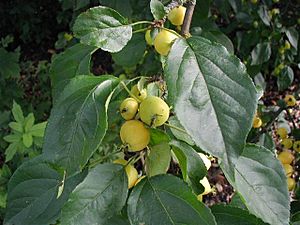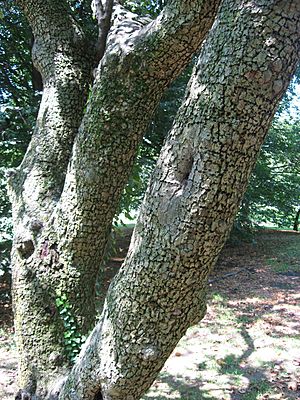Siberian crab apple facts for kids
Quick facts for kids Siberian crab apple |
|
|---|---|
 |
|
| Conservation status | |
| Scientific classification |
The Siberian crab apple (also known as Malus baccata) is a type of apple tree. It's called by a few names, like Siberian crab, Manchurian crab apple, and Chinese crab apple. This tree originally comes from many parts of northern Asia. People also grow it in other places because it's a beautiful tree and its roots are good for growing other apple trees. It's even used to create bonsai, which are tiny trees grown in pots. The Siberian crab apple tree has lots of sweet-smelling white flowers and small, edible fruits that are red or yellow and about 1 centimeter wide.
Contents
Where Siberian Crab Apples Grow
The Siberian crab apple tree naturally grows in countries like Russia, Mongolia, China, Korea, Bhutan, India, and Nepal. You can often find it in mixed forests on hillsides, growing at heights up to 1,500 meters (4,900 feet) above sea level. This tree is also found in Japan. People have brought it to Europe and North America, where it now grows wild, especially around the Great Lakes Region and in the Northeastern United States.
What Siberian Crab Apple Trees Look Like
These trees can grow quite tall, reaching about 10 to 14 meters (33 to 46 feet) high. They have branches that curve or hang down, and these branches are a reddish-brown color, just like their buds. The leaves are shaped like an oval or an egg and are about 3 to 8 centimeters long and 2 to 3.5 centimeters wide.
The Siberian crab apple tree produces beautiful white flowers that smell very nice. These flowers are about 3 to 3.5 centimeters wide and usually grow in groups of 4 to 6. The petals are white and egg-shaped.
The fruits are small and round, only about 1 centimeter (0.4 inches) across. They can be red or yellow and grow in tight bunches, looking a bit like cherries from a distance. The trees bloom with flowers in the spring, and the fruits appear later in the year, usually in September or October.
How Siberian Crab Apples Are Used
People often plant Siberian crab apple trees because they are very pretty, with their lovely flowers and colorful fruits. The fruits are safe to eat and can be enjoyed fresh or dried.
This tree is one of the tallest and strongest types of apple trees. It can handle very cold weather and is good at resisting pests. Because of these qualities, scientists use it in experiments to breed and graft other types of crab apples and regular apples. For example, it's a common source of genes for other apple varieties in northern China. The Malus baccata var. mandshurica type is even used to create bonsai trees, which are miniature trees grown in pots.
See also
 In Spanish: Manzano silvestre de Siberia para niños
In Spanish: Manzano silvestre de Siberia para niños



